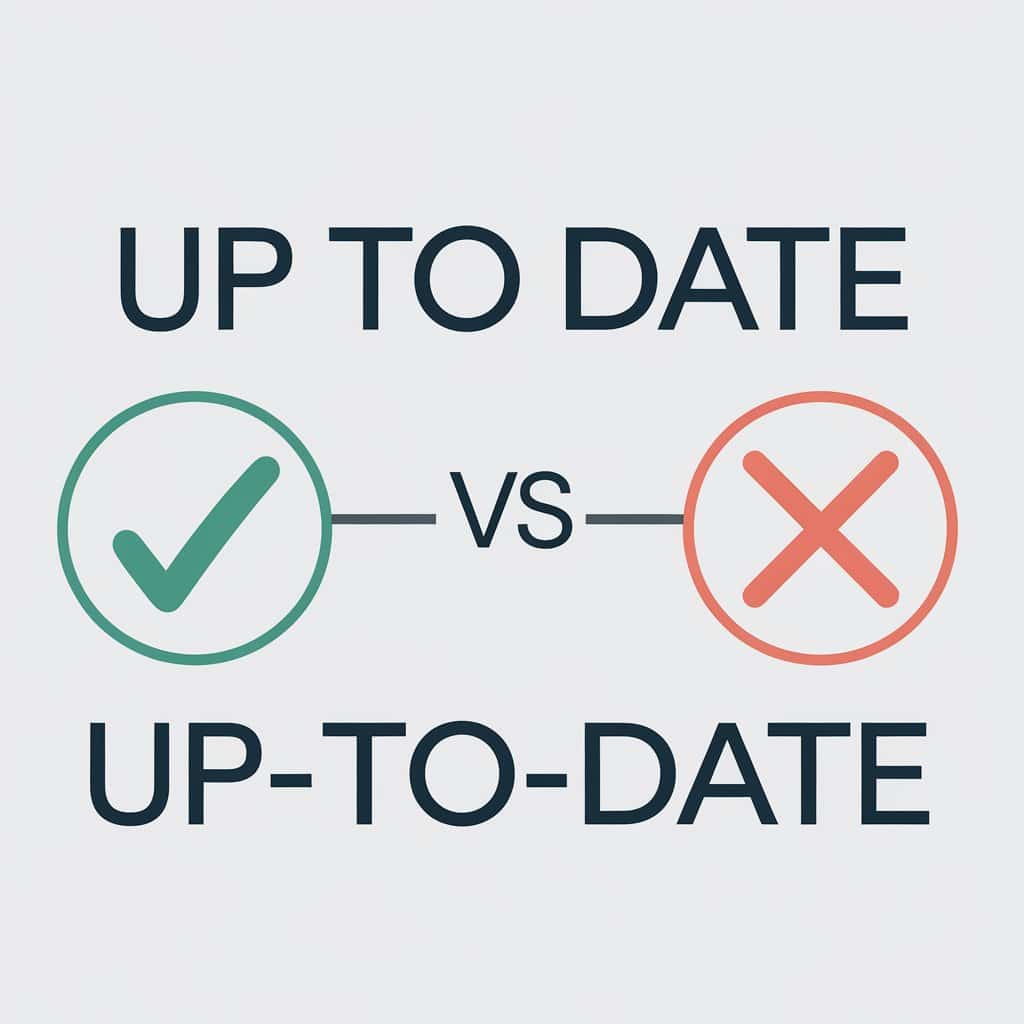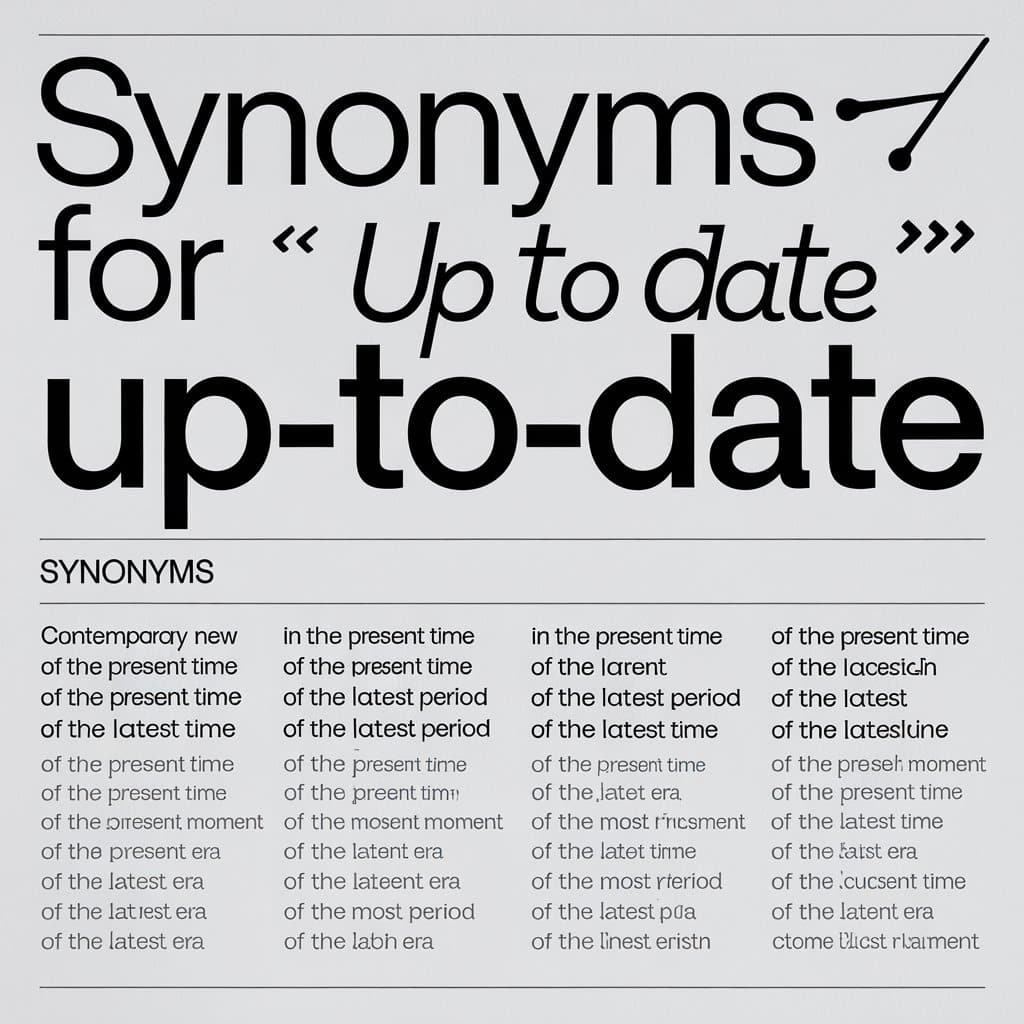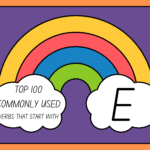If you’ve ever found yourself stuck between writing “up to date” or “up-to-date”, you’re not alone. This small grammatical dilemma confuses many writers, but it’s important to get it right. The difference between these two terms isn’t just a matter of spelling—understanding their meanings, usage, and context can drastically improve the clarity of your writing.
In this post, we’ll dive into the nitty-gritty details of “up to date” versus “up-to-date,” exploring their definitions, correct usage, and potential pitfalls. We’ll also offer useful synonyms and guide you in choosing the right term for your specific writing needs.
Why is There Confusion?
The confusion surrounding “up to date” or “up-to-date” arises because they are similar in both meaning and appearance, with one subtle difference: hyphenation. Despite their shared root, they function differently in sentences. “Up to date” is generally an adverbial phrase, whereas “up-to-date” is used as an adjective. This shift in function is often overlooked, leading to frequent mistakes.
The subtlety of the distinction, combined with the flexibility of language, makes it easy to misuse these terms. It’s critical to understand when and why one form is preferred over the other.
What Does “Up to Date” Mean?

It is an adverbial phrase that describes something that is current or has been recently updated. It emphasizes that something is kept or brought to a state of relevance, often indicating timeliness or accuracy.
Example Sentences:
- “The company website is up to date with the latest information.”
- “She keeps all her records up to date to stay organized.”
In both examples, the phrase “up to date” modifies a verb (“is” and “keeps”), showing that the action being described is happening in the present and is current.
What Does “Up-to-Date” Mean?
It refers to something that is current, modern, or has been updated with the most recent information or features. It’s used to describe a state of being fully informed or equipped with the latest updates, advancements, or knowledge.
Example:
The up-to-date software on my laptop ensures that I have access to the newest features and security patches, making my system safer and more efficient.
(In this case, “up-to-date” describes the software as being current, reflecting the latest version and improvements.)
Up to Date vs Up-to-Date: The Key Differences

Here’s a table summarizing the key differences between “Up to Date” or “Up-to-Date”:
| Aspect | Up to Date | Up-to-Date |
| Grammatical Function | Adverbial phrase | Adjective |
| Role in a Sentence | Modifies a verb or an adjective | Modifies a noun |
| Meaning | Describes the action of being current or updated | Describes a noun as current or updated |
| Example 1 | “I always keep my records up to date.” | “She gave an up-to-date presentation.” |
| Example 2 | “Please make sure to keep your information up to date.” | “This is the up-to-date version of the report.” |
| Use in Technology Context | Describes the action of keeping something current | Describes a technology or software that is modern |
| Common Synonyms | Current, recent, timely, updated | Modern, cutting-edge, state-of-the-art, contemporary |
| Hyphenation | No hyphen | Hyphenated |
| Focus | Emphasizes the act of keeping something current | Emphasizes the state or condition of something being current |
| Typical Usage | Describing how something is maintained or updated | Describing the state of something as modern or updated |
This table breaks down the most important differences in terms of grammar, usage, meaning, and examples to help you understand when to use “up to date” versus “up-to-date.”
When to Use “Up to Date”
Here is an examples of when to use “up to date” in sentences, where it functions as an adverbial phrase to describe an action:
- I always make sure to keep my contact list up to date.
(Describing the action of maintaining the contact list in a current state.) - The software automatically updates to keep your system up to date.
(Describing the process of ensuring the system is current.) - We need to update the database to ensure it’s up to date.
(Describing the action of making the database current.) - Please confirm that all your records are up to date before the meeting.
(Describing the action of verifying that the records are current.) - I regularly check the news to stay up to date with current events.
(Describing the action of keeping informed about the latest events.) - It’s essential to keep your skills up to date in this fast-moving industry.
(Describing the act of maintaining current knowledge and expertise.) - She keeps her resume up to date with every new job experience.
(Describing the action of maintaining a current resume.) - The team works hard to keep the website up to date with the latest information.
(Describing the action of updating the website regularly.) - I check my bank statements every month to make sure they’re up to date.
(Describing the act of ensuring financial records are current.) - The app regularly checks for updates to stay up to date with new features.
(Describing the action of making sure the app is current and functional.)
In each example, “up to date” is used to describe the action of keeping something current, modern, or updated, and it modifies the verbs or adjectives that describe the ongoing action.
Read more about : Coach vs Couch : Definitions, Differences, and Examples
When to Use “Up-to-Date”
Here is an examples of when to use “up-to-date” in sentences, where it functions as an adjective to describe a noun:
- The report you provided was up-to-date with the latest market trends.
(Describing the report as current and reflecting the latest information.) - We need to purchase the up-to-date version of the software to ensure compatibility.
(Describing the software version as modern and the most recent release.) - Her up-to-date resume helped her land the job interview.
(Describing the resume as current and reflecting her latest qualifications.) - The up-to-date data from the survey allowed us to make informed decisions.
(Describing the data as recent and relevant for decision-making.) - This hospital uses up-to-date equipment to provide the best care.
(Describing the equipment as modern and the latest available in the field.) - I’m looking for an up-to-date guide on how to use the software.
(Describing the guide as current and containing the latest instructions.) - The up-to-date version of the app offers several new features and improvements.
(Describing the app version as modern and updated with new features.) - She presented an up-to-date analysis of the financial situation.
(Describing the analysis as current, reflecting the most recent data.) - We need up-to-date information about the weather before heading out.
(Describing the information as recent and relevant to the current situation.) - The up-to-date website design is user-friendly and visually appealing.
(Describing the website design as modern, following the latest design trends.)
In these examples, “up-to-date” is used as an adjective to describe a noun, indicating that it is modern, current, or updated with the latest available information or features.
The Importance of Context
Context is everything when it comes to choosing between “up to date” or “up-to-date.” Understanding the role each term plays in a sentence helps you make the right choice.
For example, you might say:
- “I always keep my software up to date.” (Here, “up to date” is an adverb modifying the verb “keep.”)
- “She gave an up-to-date presentation.” (In this case, “up-to-date” is an adjective modifying the noun “presentation.”)
It’s not just a matter of preference—choosing the wrong form can make your writing sound awkward or unclear.
Synonyms for “Up to Date” or “Up-to-Date”

Here are synonyms each for “Up to Date” (as an adverbial phrase) and “Up-to-Date” (as an adjective), which you can use depending on the context.
Synonyms for “Up to Date” (Adverbial Phrase):
- Current
- Recent
- Modern
- Updated
- Latest
- Contemporary
- Timely
- State-of-the-art
- Cutting-edge
- Informed
Synonyms for “Up-to-Date” (Adjective):
- Modern
- Current
- Updated
- Latest
- Contemporary
- Cutting-edge
- State-of-the-art
- Recent
- Advanced
- Trendy
These synonyms can be swapped in based on the context and whether you’re describing an action (as an adverb) or a noun (as an adjective).
You may also like : Emersion Vs Immersion : Meaning, Differences, and Examples
Choosing the Right Synonym
While synonyms can be helpful, they need to be chosen with care. For instance, “current” and “recent” may work as substitutes for “up to date” when describing actions, but “cutting-edge” or “state-of-the-art” might be more appropriate when discussing an up-to-date product or service.
Examples:
- “The up-to-date software is cutting-edge.” (Adjective: describing the software)
- “He always keeps his knowledge up to date with the latest research.” (Adverb: modifying the verb “keeps”)
When selecting synonyms, ensure they align with the sentence’s structure and intended meaning.
Examples in Context
Understanding how to use “up to date” and “up-to-date” in real-life sentences is essential to mastering these terms.
Examples Using “Up to Date” (Adverbial Phrase)
- “Make sure to keep your information up to date when applying for the job.”
- “I checked the up to date list of contacts to ensure everything was correct.”
Examples Using “Up-to-Date” (Adjective Phrase)
- “The meeting covered the up-to-date project timeline.”
- “The up-to-date data from the survey helped guide our decisions.”
Origins of “Up to Date” and “Up-to-Date”
The phrases “up to date” and “up-to-date” have been part of the English language for quite some time, though their exact origins are somewhat difficult to pinpoint. Both terms have evolved over the years and come to be associated with the idea of keeping information, technology, or practices current and relevant. Below, we’ll explore the origins of both expressions and how they came into common use.
Origins of “Up to Date”
The phrase “up to date” is an adverbial phrase that generally refers to something being current or in the most recent state. The term likely emerged from the combination of the word “up” (meaning “to or at a higher level” or “toward the present moment”) and “date,” which denotes a point in time.
Historical Development:
- The use of “up” to denote movement toward something or toward a more advanced state dates back to Middle English, where it was used to describe progress or movement toward completion.
- The word “date,” meaning a specific time or point in history, came from the Old French word “date” (which had roots in the Latin word “data,” meaning “something given” or “a given day”).
- The combination of these two concepts, “up” and “date,” likely developed in the 18th century or earlier, with the meaning “bringing something to the present moment” or “making something current.”
The phrase “up to date” then evolved to describe the act of keeping something current or modern, such as information, technology, or records. Over time, this term became more commonly used to refer to actions that involve updating or making something reflect the present state of affairs.
Origins of “Up-to-Date”
“Up-to-date” (with hyphens) emerged as an adjective, used to describe something that is current, modern, or reflecting the latest developments. This form developed from the same roots as “up to date,” but it was adapted into a compound adjective that could be used before a noun.
Historical Development:
- The hyphenated form likely came into use in the late 19th or early 20th centuries, during a period when compound words were becoming increasingly common in English. The hyphen often helped clarify the meaning and made the phrase easier to read, especially in technical or formal contexts.
- By the late 19th century, terms like “up-to-date” were used to describe things such as books, machines, and systems that were equipped with the most recent advancements.
As with “up to date,” the use of the hyphen helped the phrase function smoothly as an adjective, modifying nouns like “version,” “information,” “system,” or “equipment.”
How “Up to Date” and “Up-to-Date” Became Popular
The rise of technology and the constant push for innovation in the 20th century played a significant role in popularizing these terms. As industries rapidly advanced, the need to keep records, information, and systems “up to date” grew. Additionally, the fast-paced nature of the digital revolution in the late 20th and early 21st centuries made it even more crucial for people to keep things “up-to-date” — whether that be software updates, news, or even personal knowledge.
In the digital age, the idea of being “up-to-date” became synonymous with being informed and technologically current. Terms like “up-to-date” or “up-to-date information” have become common in business, healthcare, technology, and news media, as they convey the idea of having the most relevant, timely knowledge.
You must try this : “Humans” or “Humen”? Which One Is Correct?
Conclusion
To sum up, up to date and up-to-date are often confused, but understanding their differences can significantly improve the quality of your writing. The key distinction lies in their grammatical roles: “up to date” is an adverbial phrase that describes actions, while “up-to-date” is an adjective that describes nouns.
Always consider the context of your sentence—whether you’re describing an action or a state—before choosing between the two. And if you’re unsure, don’t hesitate to check for alternative synonyms or reword your sentence to ensure clarity and correctness.
Mastering these terms will not only boost your grammar skills but also help you write more precisely and professionally.
Sources:
- Merriam-Webster Dictionary
- The Chicago Manual of Style
- Oxford English Dictionary

John David is an experienced blogger at Grammar Blend, passionate about language and communication. With a keen eye for grammar and clarity, he shares practical tips and tools to help readers improve their writing skills. His insightful articles make grammar accessible and engaging for learners of all levels.








I¦ve recently started a site, the information you offer on this website has helped me tremendously. Thank you for all of your time & work.